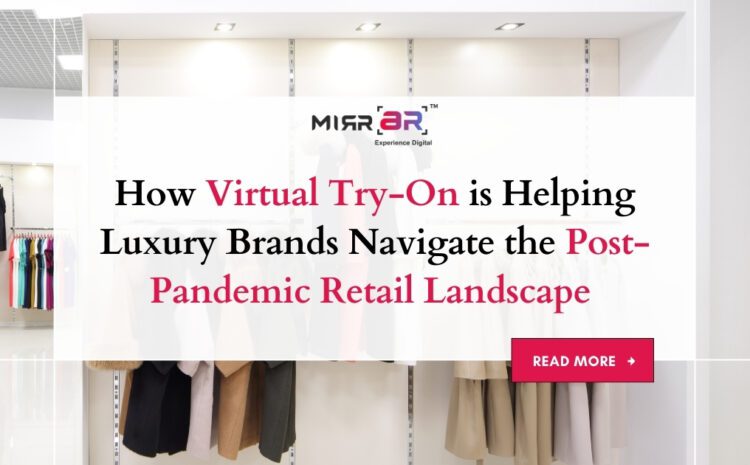The COVID-19 pandemic transformed global consumer behavior, disrupting industries and challenging traditional retail models. Nowhere was this shift more evident than in the luxury fashion sector, where customer experience and tactile interaction once reigned supreme. As storefronts closed and foot traffic dwindled, luxury brands found themselves grappling with a new, digitally-driven reality. One innovation that has emerged as a game-changer in this space is Virtual Try-On (VTO) — a technology that bridges the physical-digital divide while preserving exclusivity, personalization, and brand prestige.
The Digital Pivot: A Necessary Evolution for Luxury
Luxury brands have historically been hesitant to fully embrace digital tools, fearing that online experiences could dilute the exclusivity of their offerings. But the pandemic left no room for resistance. To maintain customer engagement and drive sales in a contactless world, many turned to VTO solutions powered by Augmented Reality (AR) and Artificial Intelligence (AI).
MirrAR’s Virtual Try-On platform enabled luxury brands to provide immersive, high-fidelity product trials directly to their customers’ devices. Whether it’s high-end jewelry, watches, eyewear, or couture garments, VTO made it possible for shoppers to visualize products on themselves in real-time — from the comfort of their homes. This eliminated the friction of online shopping and addressed a core concern: “How will it look on me?”
Enhancing Engagement and Conversion
In a post-pandemic retail world, engagement is currency. VTO doesn’t just display a product — it invites interaction. By enabling customers to see how a luxury item looks and fits virtually, brands are now creating personalized journeys that drive deeper engagement. Research shows that AR-powered virtual try-on tools can increase conversion rates by up to 94% compared to traditional e-commerce interfaces.
Customers spend more time on sites that offer VTO, leading to higher purchase intent. In addition, the experience builds confidence in purchase decisions, reducing return rates — a major cost concern for online retailers, especially in luxury where items are high in value and logistics complex.
Rebuilding Consumer Trust Through Hygiene and Safety
As physical stores began reopening post-pandemic, consumer expectations around hygiene and safety remained high. The luxury experience, once heavily reliant on in-store trials and concierge-style service, had to adapt quickly. In-store VTO tools like smart mirrors and gesture-controlled AR displays offered a touch-free, hygienic way to try on products. Customers could visualize how a necklace or pair of sunglasses would look without physically wearing them — addressing both safety concerns and the need for personalized attention.
For luxury retailers, integrating MirrAR’s VTO platform in physical stores meant offering a futuristic, tech-enhanced experience while safeguarding their clientele’s health — a win-win for both brand image and customer comfort.
Global Reach and Market Expansion
Luxury consumers are no longer confined to the fashion capitals of Paris, Milan, or New York. Post-pandemic, online luxury shopping saw a sharp rise across emerging markets — from Southeast Asia to the Middle East. Virtual Try-On enables brands to reach these audiences without investing in physical retail infrastructure. Customers from anywhere in the world can enjoy a personalized, immersive experience that mirrors the boutique feel — enhancing brand accessibility without compromising exclusivity.
This scalability empowers luxury brands to test new geographies and demographics with minimal risk. Whether launching a new line or entering a new region, VTO provides real-time insights into consumer behavior, preferences, and product popularity.
Reinforcing Sustainability Goals
Another priority accelerated by the pandemic is sustainability. VTO plays a crucial role in supporting luxury brands’ eco-conscious initiatives. By minimizing the need for sample production, packaging, and returns, virtual try-on helps significantly reduce waste and carbon emissions. It also helps brands build a narrative of innovation aligned with environmental responsibility — a trait increasingly valued by modern luxury consumers.
With platforms like MirrAR offering real-time try-on with high accuracy, brands can move away from overproduction and toward demand-driven design — one that’s data-informed and digitally tested before hitting the shelves.
Reinventing Personalization in a Contactless World
Luxury retail is defined by personalization. With AI-backed VTO platforms, brands can now offer hyper-personalized experiences even in a contactless setting. MirrAR’s solution can analyze user preferences, facial geometry, skin tone, and previous interactions to recommend products that fit and flatter — elevating the try-on experience to a curated, concierge-level service.
Moreover, integrating VTO with CRM systems allows for rich data collection. Brands can build smarter customer profiles, segment audiences, and deliver tailored campaigns that speak to individual tastes — a powerful tool in an era of digital saturation.
Also Read: How Virtual Try-On is Shaping the Next Generation of Online Shopping Experiences
Looking Ahead: VTO as the Future of Experiential Retail
As the luxury industry adapts to a permanently hybrid retail model, Virtual Try-On is not just a pandemic workaround — it’s a long-term strategic asset. It empowers brands to merge digital convenience with emotional storytelling, offering consumers an experience that is interactive, intelligent, and indulgent.
With tech platforms like MirrAR continuously innovating to enhance realism, speed, and personalization, the line between digital and physical luxury is blurring. Whether through smart mirrors in flagship stores or immersive AR in mobile apps, VTO is becoming the cornerstone of the luxury retail experience in a post-pandemic world.
Conclusion
Virtual Try-On has proven to be more than just a novel feature — it’s a vital tool helping luxury brands rebuild stronger, smarter, and more connected to their global audiences. As we look ahead, the most successful luxury players will be those who not only adopt this technology but integrate it into the very fabric of their customer experience. With MirrAR leading the way, the future of luxury retail looks immersive, innovative, and irresistibly personal.
